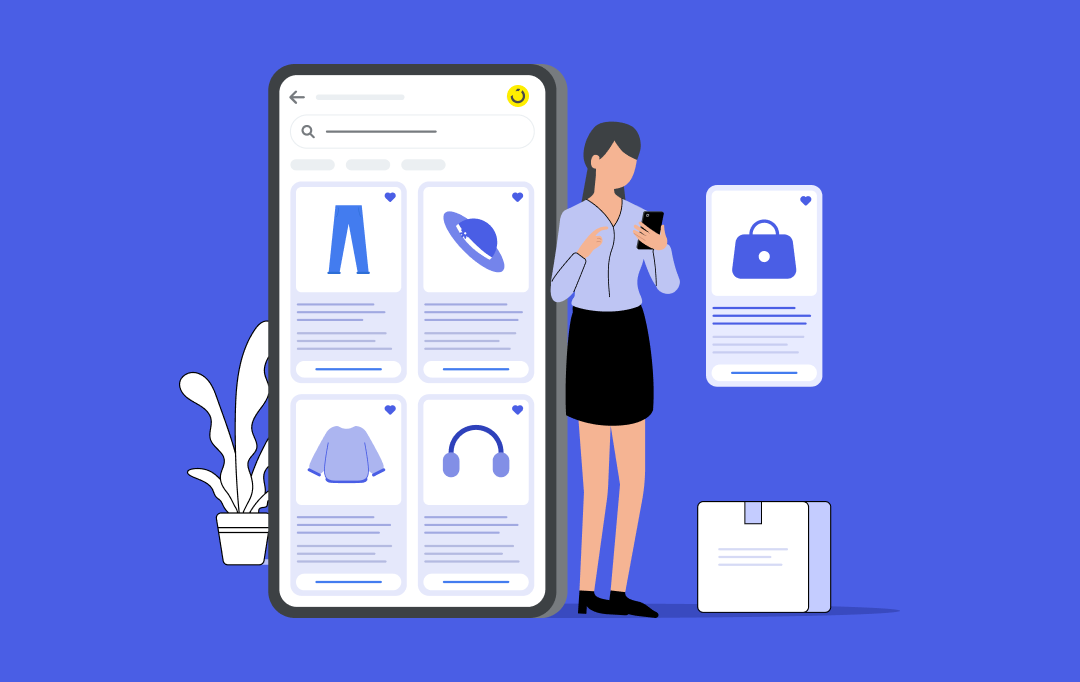- Why is Shopping Cart Abandonment a Common Issue in Ecommerce Apps?
- Shopping Cart Abandonment Statistics
- How to Calculate Cart Abandonment Rate?
- How to Reduce Cart Abandonment Rate with your Ecommerce App?
- 1. Guest Checkout
- 2. Device Optimization
- 3. Optimize Product Pages
- 4. Add to Smart Wish List
- 5. Quick Sign-Ups
- 6. Email Reminders and Push Notifications
- 7. Offer Discounts
- 8. Provide Visual Proof of Trust
- 9. Keep Options for Multiple Payments
- 10. Get an SSL Certification
- 11. Brand Familiarity is not a Myth
- 12. Eliminate Surprise Costs
- Start Optimizing your Ecommerce Store Today
- FAQs
User privacy concerns and lengthy checkout processes often partake in the accusation of a high shopping cart abandonment rate of m-commerce apps. Whereas the metrics on users’ consideration at different stages of virtual shopping, often skip the bare eye. In this read we will narrow down upon- What are the main reasons and how can m-commerce apps lower their cart abandonment rate?
Imagine you are at a shopping store. You pick all the stuff that you intend to buy and place it in your cart when suddenly your phone starts buzzing. It’s a call from your longtime friend. You lose focus from shopping, or rather forget about the shopping bucket altogether before you leave the store.
We all know that is very unlikely to happen in a brick-and-mortar store.
But for virtual shopping carts on mobile and the web, this scenario is recurring, common, and obvious.
Even the slightest interruption from calls, messages, notifications or the environment can make your buyers leave the cart without making an actual purchase.
Why is Shopping Cart Abandonment a Common Issue in Ecommerce Apps?

Shopping cart abandonment mainly occurs when the user looks for the best deals on different online shopping websites, adding products but not purchasing them. Other than that, friction in the checkout process, additional shipping costs, ambiguous refund, and return policies, lack of transparency, unexpected time of delivery, and several other reasons for shopping cart abandonment.
If you look at the stats above, the mobile app shopping cart abandonment happens mainly because of the high shipping costs. Other than that, delivery-related concerns, complex checkout processes, payment-related concerns, and user experience are other issues.
Although you will never be able to completely eliminate the problem of shopping cart abandonment, but you can obviously lower cart abandonment rate by optimizing your app and following the full-proof abandoned cart best practices. This will help you streamline your conversion rate and increase your sales.
Shopping Cart Abandonment Statistics
Shopping cart abandonment is the pain in the foot of every mcommerce or online retail store today. Vigilant marketers bring meaningful learnings about user behavior. You can try and turn your cart abandonment into key insights to restabilize all that is wrong with your marketing plan.
Let us look at the shopping cart abandonment statistics 2022, which says that the overall average documented online shopping cart abandonment rate is 69.99%. It throws light on the fact that an ecommerce app that is not meeting the requirements of the users or is not properly optimized, needs shopping cart abandonment optimization.

So how to fix cart abandonment? One thing that is fairly evident is that a good conversion rate optimization approach can sustain and re-engage your audience to lower your cart abandonment rate.
How to Calculate Cart Abandonment Rate?

Calculating your cart abandonment rate is extremely important to know how the users are interacting with your app. The approximate rate of ecommerce abandoned carts can be calculated by dividing the total number of purchases by the number of carts created. Subtract from 1 by multiplying it by 100.
For instance, if you have 400 carts created and 100 completed purchases, then your cart abandonment rate is 56%.
How to Reduce Cart Abandonment Rate with your Ecommerce App?

What if you choose to do nothing about the high cart abandonment rate?
You miss a lot of revenue and fail in conversions as your users continue to jump off the ship.
Everyone is looking for a quick fix to develop a customer base that keeps returning for more. The quest to recapture the lost value has become food for thought, for many bloggers, marketers, entrepreneurs, and agencies.
We all are users at some point in our day.
Think like one! One technique to reduce shopping cart abandonment is to get the knack of your customer’s minds to step in their shoes and generate your own perspective. What makes you snap back before you enter your card details?
Make a list of these points just like we did to arrive at the main causes for an effective abandonment cart strategy. While we took a generalist approach, you need the one specific to your business needs.
Many think of their mobile apps as currency vending machines, which they are not. Your mobile app is a platform that brings you an opportunity to develop a relationship with your customer, promote loyalty and leave a lasting impression on your heads.
1. Guest Checkout
Save your shoppers from new account fatigue. Allow them to make a purchase without creating and signing in to their user accounts.
Remember all those times when a paywall or overbearing request kept you from accessing the products on an app? Enabling guest checkout will let your customers browse through the products and share their details only when they are ready.
Understand and accept that the user wants to compare, assess and evaluate the value you offer against the purchase. Encourage users to sign up and log in once they ensure that you offer the maximum value.
In fact, the e-commerce market leaders like Amazon, Walmart, and others are already doing it. They all have a one-step checkout implementation option on their mobile apps.
Also Read- Fruitful Ways to Simplify Ecommerce App’s Checkout Process
2. Device Optimization
With smartphones taking over the internet, another thing you would like to consider is the device your customers are using to access your website. Users spend about 15 hours a week on their smartphone browsing products on different m-commerce applications. Once the users set their eyes on a product, about 45% switch to their laptops or tablets to make the purchase.
Make the mobile-responsive design your first priority. This approach is a great value add to your competitive growth. Optimize your website for mobile shoppers.
Come to think of it from a user’s point of view. A user who comes to your site has already been there through a smartphone.
Mobile shopping cart abandonment rates are high pertaining to casual browsers. Carts abandoned on mobiles are reopened on websites. So if you let them save the products that they like, you can seal the deal. Later they will come to your site with their visa and keyboards.
At Appinventiv, we worked with an ecommerce platform, 6th Street that was facing a huge challenge of an overall poor user experience.
6th Street wanted to boost the same and our experts immediately came to the rescue. By integrating user-friendly features, fixing Algolia SDK, implementing Algolia analytics, and restructuring their product listing screen design, our team enhanced the shopping experience for their users.
3. Optimize Product Pages
When online shoppers land on a particular product page and leave without getting those added to their cart or wishlist, the abandonment rate of your website’s product page increases. People leave a product page often without even interacting with it because they are not getting the proper information that they require about the product or the website is not user-friendly enough.
Consider adding specific features to your product page that would bring in more engagement. For instance, you can try adding multiple photos with high-end animations and resolutions along with adding product descriptions and FAQs that would answer the query of the users.
Adding videos and images of the product would be more beneficial as it will show people how to utilize the same. Also, remember that if your product page is cluttered with too much information, then it will be very confusing for the people if they should buy the product or not. Overall, the page should be crystal clear and easy to navigate for the individual shopper to add the products to their carts.
Our team also worked with an ecommerce client called Edamama, which is popular for offering personalized shopping experiences for busy mothers. Our experts worked on detailing the product category tree and built up a predefined flash sale timeline system.
They also upgraded the app’s features that helped the mothers seamlessly register with the platform and browse personalized product recommendations based on the details of the child’s age and gender shared by them.
4. Add to Smart Wish List
We all have a long list of items that we want to purchase. A wish list lets your user bundle all on that list. With emerging technologies, Smart Wish List can make you stand out and nurture your audience.
But very few applications have the Wish List feature.
Take an example of an m-commerce app that deals in clothes. Suppose a user really likes a scarf but can’t find a matching pullover with it. The wishlist helps your customers to make a bundle of items in their own time.
Another scenario can be that you are out of stock and running low on the inventory of the pullover. The user can simply add it to the wish list. Once the stock is in the inventory, the user gets automatically notified.
The wishlist can also help manufacturers make pre-launch bookings, for instance on new gadgets, before the price is disclosed. This brings a lot of customer feedback to retailers and manufacturers to devise combos, offers, and discounts on selective merchandise. These are all part of the shopping cart page best practices.
Now make the wish list feature smart. Add options to categorize the wish list for birthdays, anniversaries, paydays, and others. Allow users to share their wishlists with others.
A little push can add the right spices and increase sales revenue. Add a ‘buy before’ criteria to the wish list to bring a sense of urgency. Suppose an expiry time of 60 days can bring the shoppers back before their itinerary disappears into the black hole forever.
5. Quick Sign-Ups
It’s good if you are not forcing user registration. But it does more harm if you do not remind your shoppers to log in before they go. Keeping it simple and subtle can capture the user’s attention.
‘Sign up with Google’ is a simple yet strong call to action. Users recognize google in a blink. It is secure, familiar, and ideal. Give users the perception of choice, with a quick sign-up.
This also tells you about when, where, and how users prefer to communicate with you. So strive to secure your m-commerce app using best practices of network encryption.
6. Email Reminders and Push Notifications
Communicate with your customers to re-stimulate their interest. One of the wise old tricks of marketing is direct communication with your user. Workaround a great email reminder campaign. Being too zealous won’t put you on the right foot here, like bombarding the inboxes with a streak of reminders. By rule of thumb, here is a list of what a good reminder email encloses:
- Vibrant images of the product- To remind the buyer
- A strong call to action- To stimulate decision making
- Brief service guarantee or refund policy- To alleviate any concerns
Another alternative you have is of smart push notifications. If you make good offers the ones that bring a sense of cost incentive to the users, you will hit the jackpot.
7. Offer Discounts
Cutting down prices may critically affect your bottom line. But it’s a good bait to drive in the shoppers waiting on the fence.
A study of the effect of price discounts and bonus packs on online impulse buying speaks of the impact on users. Percentage discounts make the best detours for items bought for pleasure, while combos and bonus packs work best for utilitarian items.
There is no other better way to drive customers to your website than by making them aware of the latest discounts and offers of your brand either via social media, push notifications, or emails. Discount and promo codes actually work and spike your conversion rate and sales.
Time-bound discount offers on items with elastic prices can show your intent that you value your customers. And to a customer, that is a great feeling.
8. Provide Visual Proof of Trust
Did you know that trust badges have a positive impact on the website’s conversion rate and overall sales? These badges make the users feel better and trusted about giving their credit or debit card information to an unfamiliar site.
This automatically results in generating a positive impact among the new customers. These badges impact the overall order value, thus indicating how customers feel better about placing larger orders with the websites they actually trust.
9. Keep Options for Multiple Payments
It is a proven concept that the cart abandonment rate gets reduced to almost 8% if you integrate multiple payment options into your website. Users like having multiple options when it comes to making payments on your e-commerce site. Having multiple payment options increases the trust of users and also provides them the convenience choose their preferred mode of payment.
If you own an ecommerce store, then you should always consider the primary platform as native mobile and not web. Because the conversion rate in mobile web is 6%, whereas, in the native mobile, it is 21%, which is almost 4x times higher than in favor of the native mobile.
10. Get an SSL Certification
Security for the payment or the transactions made by the user should be end-to-end encrypted. Payment security plays a major role in earning the customer’s or the user’s trust. However, you can lose your customers if you do not have the SSL certification. This can create a negative impact on your e-commerce store.
Google blacklists almost 10,000 websites every week that pose a great threat of malware attack. When the customers visit your payment page and note that it does not have an SSL certificate, then they abandon the cart and leave. This also results in the uninstallation of your app. With an SSL certificate, you can reduce cart abandonment.
Bonus Read- How to Develop an M-Commerce App and Maintain its Security?
11. Brand Familiarity is not a Myth
Google Trusted Store badge is one heck of a tag that ensures certainty, reliability, and trust factor through visual representations.
A name that your buyer has not heard before is bound to add skepticism about your credibility and offerings. Promote your brand to raise familiarity with your audience. Showing up in google search or social media advertisements will not bring you great returns.
12. Eliminate Surprise Costs
High shipping costs and taxes often switch off the buying intent of customers. Free shipping on orders above a certain value is not a new idea but the one that makes magic happen. Disclose the additional costs early in the buying funnel.
Start Optimizing your Ecommerce Store Today
While shopping on a mobile device, customers or users expect fluidity, ease of navigation, speed, and security, all throughout their experience. However, when they experience any kind of glitch or unnecessary longer and more complex steps, they would likely abandon their cart or leave the app as well.
Offering a smoother guest checkout, making security a priority, optimizing the product pages, and putting up a proper real-time customer support section and several other features will help reducing cart abandonment rate.
A Forrester study confirms that surprise costs make 44 percent of online shoppers drift away and uninstall the apps.
Make a serious attempt to reduce all potential barriers between you and the wallet of your users. An active, persistent approach to curb the checkout leaks, navigation, and performance issues are a few other things to spot.
Ecommerce shopping cart abandonment solutions are easy to implement if you understand their customers. Implementing the right techniques to reduce shopping cart abandonment, as discussed above will soon make the bounce rates wind down, and conversions ramp up.
Want to drive more e-commerce conversions and lower cart abandonment rates? Get the best cart abandonment solution from an ecommerce app development company like us.
FAQs
Q. How to reduce cart abandonment?
A. Here are a few steps to reduce cart abandonment rate:
- Optimize your checkout process
- Calculate your cart abandonment rate
- Segment your abandoned cart visitors
- Send them an email
- Offer free shipping
- Enable guest checkout
- Get an SSL certificate
- Optimize product pages
Q. What are some of the top cart abandonment causes?
A. Here are some of the top cart abandonment causes:
- Confusing or long check-out process
- Mandatory account creation process
- Unexpected shipping cost
- Unsafe payment methods
- Restrictions on product quantity
- Lesser payment options
- Comparison shopping
- Complex return and refund policies
- Unexpected time of delivery
- Poor site speed or app loading issue
- No discount or promo codes
- Additional or hidden charges
These issues can be averted by hiring a reputed ecommerce app development company like Appinventiv that can help you in cart abandonment app development.
Q. How does shopping cart abandonment affects inventory management?
A. When a user adds a product to their cart, the product gets removed from the inventory and is shown unavailable or lesser in stock for purchase by other users. Therefore, an abandoned cart not just indicates a missed sale, but also stops other customers or users from buying those products; at least for a temporary period of time.
Q. How shopping cart abandonment could create problems for the online retailer?
A. Shopping cart abandonment is a problem for online retailers because when customers do not checkout, they miss a sale. It doesn’t matter whether the order was small or large. For instance, the customers do not intentionally abandon the cart. This means that there are glitches in your app or it has several complex features which is why the customer has decided to quit your app and head to the competitor’s app.
Q. At which stage does the user abandon their shopping cart?
A. Shopping cart abandonment frequently happens in the checkout section, which is the stage where the user has already decided to buy the product. It can happen on any platform, including mobile and web. It’s no wonder that the most abandoned cart cases happen on mobile as more and more people have now started to utilize the benefits of a native mobile app.
However, the ecommerce sellers still haven’t learned their lessons properly and are not optimizing their applications or they do not know the reasons why their retail business needs a mobile app. This is where the mobile apps are faltering behind the rest. Only by utilizing abandoned cart best practices and cart abandonment optimization, ecommerce businesses can maintain a decent conversion rate.


- In just 2 mins you will get a response
- Your idea is 100% protected by our Non Disclosure Agreement.

Key takeaways: Outdated systems cause inefficiencies, poor customer experiences, and missed opportunities. Appinventiv helped a US retailer achieve a 25% sales increase and 15% growth in AOV post-transition. Real-time data enhances customer experiences and reduces the cart abandonment rate The new platform handled 3x traffic during peak periods, supporting future growth. Ever noticed how fast…

How Much Does It Cost to Build an E-commerce App Like Noon?
Key takeaways: Noon’s success highlights the rising demand for mobile-first eCommerce in the UAE. Building a similar app can cost anywhere between $ 30,000 and $200,000+, depending on the scope. The blog covers all key user and admin features needed to build a Noon-like app. Identify key cost drivers, including feature complexity, scalability, platform, and…

How to Build a Quick Commerce App? Features, Process, Costs
Key Takeaways Quick commerce is a rapidly growing market driven by consumer demand for ultra-fast delivery and seamless convenience, projected to reach 900 million users by 2029. Quick commerce app development costs vary widely based on features and scale, ranging from $40,000 for an MVP to $400,000+ for a fully featured app. Core features, such…

















